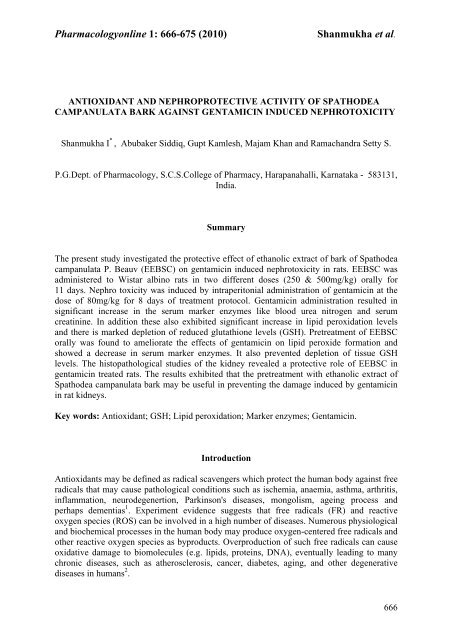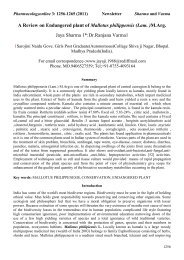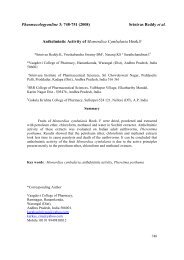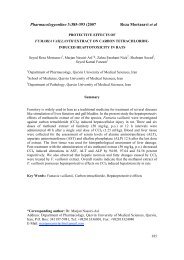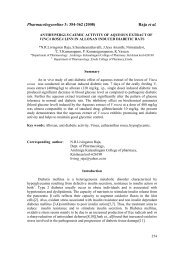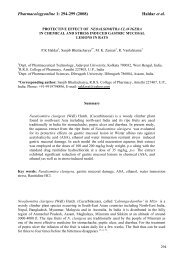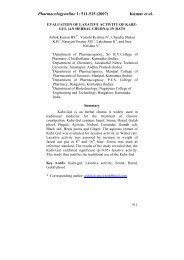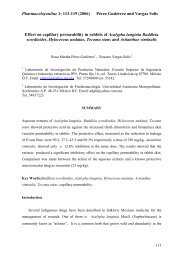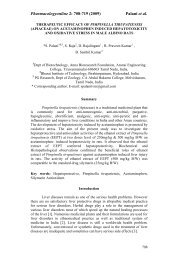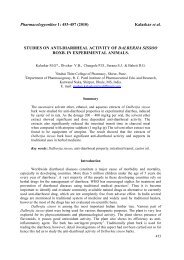Antioxidant and Nephroprotective Activity of Spathodea ...
Antioxidant and Nephroprotective Activity of Spathodea ...
Antioxidant and Nephroprotective Activity of Spathodea ...
Create successful ePaper yourself
Turn your PDF publications into a flip-book with our unique Google optimized e-Paper software.
Pharmacologyonline 1: 666-675 (2010) Shanmukha et al.<br />
ANTIOXIDANT AND NEPHROPROTECTIVE ACTIVITY OF SPATHODEA<br />
CAMPANULATA BARK AGAINST GENTAMICIN INDUCED NEPHROTOXICITY<br />
Shanmukha I * , Abubaker Siddiq, Gupt Kamlesh, Majam Khan <strong>and</strong> Ramach<strong>and</strong>ra Setty S.<br />
P.G.Dept. <strong>of</strong> Pharmacology, S.C.S.College <strong>of</strong> Pharmacy, Harapanahalli, Karnataka - 583131,<br />
India.<br />
Summary<br />
The present study investigated the protective effect <strong>of</strong> ethanolic extract <strong>of</strong> bark <strong>of</strong> <strong>Spathodea</strong><br />
campanulata P. Beauv (EEBSC) on gentamicin induced nephrotoxicity in rats. EEBSC was<br />
administered to Wistar albino rats in two different doses (250 & 500mg/kg) orally for<br />
11 days. Nephro toxicity was induced by intraperitonial administration <strong>of</strong> gentamicin at the<br />
dose <strong>of</strong> 80mg/kg for 8 days <strong>of</strong> treatment protocol. Gentamicin administration resulted in<br />
significant increase in the serum marker enzymes like blood urea nitrogen <strong>and</strong> serum<br />
creatinine. In addition these also exhibited significant increase in lipid peroxidation levels<br />
<strong>and</strong> there is marked depletion <strong>of</strong> reduced glutathione levels (GSH). Pretreatment <strong>of</strong> EEBSC<br />
orally was found to ameliorate the effects <strong>of</strong> gentamicin on lipid peroxide formation <strong>and</strong><br />
showed a decrease in serum marker enzymes. It also prevented depletion <strong>of</strong> tissue GSH<br />
levels. The histopathological studies <strong>of</strong> the kidney revealed a protective role <strong>of</strong> EEBSC in<br />
gentamicin treated rats. The results exhibited that the pretreatment with ethanolic extract <strong>of</strong><br />
<strong>Spathodea</strong> campanulata bark may be useful in preventing the damage induced by gentamicin<br />
in rat kidneys.<br />
Key words: <strong>Antioxidant</strong>; GSH; Lipid peroxidation; Marker enzymes; Gentamicin.<br />
Introduction<br />
<strong>Antioxidant</strong>s may be defined as radical scavengers which protect the human body against free<br />
radicals that may cause pathological conditions such as ischemia, anaemia, asthma, arthritis,<br />
inflammation, neurodegenertion, Parkinson's diseases, mongolism, ageing process <strong>and</strong><br />
perhaps dementias 1 . Experiment evidence suggests that free radicals (FR) <strong>and</strong> reactive<br />
oxygen species (ROS) can be involved in a high number <strong>of</strong> diseases. Numerous physiological<br />
<strong>and</strong> biochemical processes in the human body may produce oxygen-centered free radicals <strong>and</strong><br />
other reactive oxygen species as byproducts. Overproduction <strong>of</strong> such free radicals can cause<br />
oxidative damage to biomolecules (e.g. lipids, proteins, DNA), eventually leading to many<br />
chronic diseases, such as atherosclerosis, cancer, diabetes, aging, <strong>and</strong> other degenerative<br />
diseases in humans 2 .<br />
666
Pharmacologyonline 1: 666-675 (2010) Shanmukha et al.<br />
Gentamicin is an important aminoglycoside anti-biotic commonly used in treating lifethreatening<br />
gram-negative infections 3 . However its usefulness is limited by signs <strong>of</strong><br />
nephrotoxicity, which may occur in 13-30% <strong>of</strong> treated patients 4 . Lipid peroxidation may<br />
occur in the course <strong>of</strong> gentamicin administration 5 , giving rise to free radicals 6 , which are<br />
highly toxic to tissue 7 . Oxidation <strong>and</strong> necrosis by apoptosis may occur. Several plant products<br />
are known to exhibit credible medicinal properties for the treatment <strong>of</strong> kidney ailments <strong>and</strong><br />
need to be explored to identify their potential application in prevention <strong>and</strong> therapy <strong>of</strong> human<br />
ailments.<br />
<strong>Spathodea</strong> campanulata P. Beauv <strong>of</strong> family Bignoniaceae commonly known as African tulip<br />
tree is planted in gardens <strong>and</strong> avenues, is reported to be useful in the treatment as diuretic,<br />
anti-inflammatory, for kidney diseases, antidote, enemas, herpes, stomach ache,<br />
antisecretolytic, anti parasitic, urethra inflammations, fungal skin diseases, diarrohea, anti-<br />
HIV, anti-malarial <strong>and</strong> hypo glycemic activity 8,9 . The major chemical constituents <strong>of</strong> the<br />
plant are steroids, cardiac glycosides, flavonoids, tannins <strong>and</strong> polyphenols. Ayurveda<br />
recommends <strong>Spathodea</strong> campanulata in the treatment <strong>of</strong> kidney disorders <strong>and</strong> the literature<br />
survey also confirms the use <strong>of</strong> the titled plant in kidney disorders. Hence the present study<br />
was undertaken to evaluate the in-vitro <strong>and</strong> invivo antioxidant <strong>and</strong> nephroprotective potential<br />
<strong>of</strong> ethanolic extract <strong>of</strong> <strong>Spathodea</strong> campanulata bark in gentamicin induced biochemical <strong>and</strong><br />
histopathological changes.<br />
Materials <strong>and</strong> methods<br />
Plant material <strong>and</strong> extraction: <strong>Spathodea</strong> campanulata bark was collected from the<br />
Davanagere city around road side in the month <strong>of</strong> June 2009. The plant was identified <strong>and</strong><br />
authenticated by Pr<strong>of</strong>. K. Prabhu, Department <strong>of</strong> Pharmacognosy, S.C.S. College <strong>of</strong><br />
Pharmacy, Harapanahalli. A herbarium specimen is preserved in the college museum. The<br />
bark was shade dried separately at room temperature <strong>and</strong> pulverized. The powder obtained<br />
was subjected to successive soxhlet extraction with the solvents with increasing order <strong>of</strong><br />
polarity i.e. pet. Ether (60-80°), chlor<strong>of</strong>orm (59.5-61.5°), 70% ethanol (64.5-65.5°) <strong>and</strong> water.<br />
The shade-dried powder was extracted with 70% ethanol (hydro-alcoholic extract) after<br />
deffating with petroleum ether, which was used for biological investigations <strong>and</strong> in-vitro <strong>and</strong><br />
in-vivo antioxidant studies, after subjecting it to preliminary qualitative phytochemical<br />
studies. The extracts were concentrated to a small volume using flash evaporator <strong>and</strong> further<br />
evaporated to dryness <strong>and</strong> stored in a vaccum dessicator until further use <strong>and</strong> the percentage<br />
yield <strong>of</strong> corresponding extracts were calculated.<br />
Chemicals: Gentamicin is obtained from sorus labs, Pithampur, Paracetamol from S d fine<br />
chemicals, the biochemical kits from Erba Manheim, Germany <strong>and</strong> all other chemicals used<br />
were <strong>of</strong> analytical grade.<br />
Animals: Wistar albino rats (weighing 150-250g) <strong>and</strong> albino mice (weighing 20-25g) <strong>of</strong><br />
either sex were used in this study. They were procured from Sri Venkateshwara Enterprises,<br />
Bangalore. The animals were acclimatized for one week under laboratory conditions. They<br />
were housed in polypropylene cages <strong>and</strong> maintained at 27°C ± 2°C under 12 hrs dark / light<br />
cycle. They were fed with st<strong>and</strong>ard rat feed (Gold Mohur Lipton India Ltd.) <strong>and</strong> water ad<br />
libitum was provided. The husk in the cages was renewed thrice a week to ensure hygeinity<br />
<strong>and</strong> maximum comfort for animals. Ethical clearance for h<strong>and</strong>ling the animals was obtained<br />
from the Institutional animal ethical committee prior to the beginning <strong>of</strong> the project work,<br />
according to prescribed guidelines <strong>of</strong> committee for the purpose <strong>of</strong> control <strong>and</strong> supervision <strong>of</strong><br />
667
Pharmacologyonline 1: 666-675 (2010) Shanmukha et al.<br />
experiments on animals (CPCSEA), under the ministry <strong>of</strong> animal welfare division,<br />
Government <strong>of</strong> India, New Delhi.<br />
Acute toxicity study: Acute toxicity study was carried out using albino mice (20-25g) for<br />
EEBSC in accordance with OECD guideline No. 420 given by CPCSEA 10 was adopted for<br />
toxicity studies. The extract was found to be devoid <strong>of</strong> mortality at 2000mg/kg. Hence, 2500<br />
mg/kg was considered as LD50 cut<strong>of</strong>f value. Hence the 1/ 10 th (250 mg/kg, p.o.) <strong>and</strong> 1/ 5 th<br />
(500mg/kg, p.o.) <strong>of</strong> the dose selected for the screening <strong>of</strong> nephroprotective activity.<br />
In vitro <strong>Antioxidant</strong> activity:<br />
The following in-vitro models were carried out to evaluate antioxidant activity.<br />
a) Reducing power.<br />
b) Nitric oxide radical scavenging activity.<br />
a) Reducing Power: This method is based on the principle <strong>of</strong> increase in the absorbance <strong>of</strong><br />
the reaction mixture. Increase in the absorbance indicates increase in the antioxidant activity.<br />
In this method antioxidant compound forms a colored complex with potassium ferricyanide,<br />
trichloro acetic acid <strong>and</strong> ferric chloride, which is measured at 700nm. Increase in absorbance<br />
<strong>of</strong> the reaction mixture indicates the reducing power <strong>of</strong> the samples. The reducing power <strong>of</strong><br />
70% ethanolic extract <strong>of</strong> bark <strong>of</strong> <strong>Spathodea</strong> campanulata P. Beauv was determined according<br />
to the method <strong>of</strong> Oyaizu (Oyaizu, 1986) 11, 12 .<br />
Procedure: Different doses <strong>of</strong> 70% ethanolic extract <strong>of</strong> <strong>Spathodea</strong> campanulata P. Beauv<br />
were mixed in 1 ml <strong>of</strong> distilled water so as to get 25µg, 50µg, 75µg, 100µg, 125µg<br />
concentration. This was mixed with phosphate buffer (2.5 ml, 0.2 M, pH 6.6) <strong>and</strong> potassium<br />
ferricyanide (2.5ml, 1%). The mixture was incubated at 50°C for 20 minutes. A portion (2.5<br />
ml) <strong>of</strong> trichloroacetic acid (10%) was added to the mixture, which was then centrifuged at<br />
3000 rpm for 10 minutes if precipitate occurs. The upper layer <strong>of</strong> the solution (2.5 ml) was<br />
mixed with distilled water (2.5 ml) <strong>and</strong> FeCl3 (0.5 ml, 0.1%), <strong>and</strong> the absorbance (OD) was<br />
measured at 700nm.<br />
Increased absorbance <strong>of</strong> the reaction mixture indicates increase in reducing power. The %<br />
reducing power was calculated by using following formula:<br />
Test OD – Control OD<br />
% increase in absorbance = × 100<br />
Control OD<br />
b) Nitric oxide radical scavenging activity 13 : Nitric oxide (NO) is an important chemical<br />
mediator generated by endothelial cells, macrophages, neurons, etc. <strong>and</strong> involved in the<br />
regulation <strong>of</strong> various physiological processes. Excess concentration <strong>of</strong> NO is associated with<br />
several diseases. Oxygen reacts with the excess nitric oxide to generate nitrite <strong>and</strong><br />
peroxynitrite anions, which act as free radicals. This forms the basis <strong>of</strong> this experiment.<br />
668
Pharmacologyonline 1: 666-675 (2010) Shanmukha et al.<br />
Procedure: Nitric oxide (NO) radical were generated from sodium nitroprusside solution at<br />
physiological pH. Sodium nitroprusside (1ml <strong>of</strong> 10mM) were mixed with 1ml <strong>of</strong> 70%<br />
ethanolic extract <strong>of</strong> bark <strong>of</strong> <strong>Spathodea</strong> campanulata P. Beauv <strong>of</strong> different concentration (25-<br />
125 µg/ml) in phosphate buffer (pH 7.4). The mixture was incubated at 25°C for 150 min.<br />
To 1 ml <strong>of</strong> the incubated solution, 1ml <strong>of</strong> Griess’s reagent (1% sulphanilamide, 2% ophosphoric<br />
acid <strong>and</strong> 0.1% naphthyl ethylene diamine dihydrochloride) was added.<br />
Absorbance was read at 546 nm. Decreased absorbance <strong>of</strong> the reaction mixture indicates<br />
increased nitric oxide radical scavenging activity. % inhibition <strong>of</strong> OD was calculated by the<br />
formula.<br />
<strong>Nephroprotective</strong> activity:<br />
Control OD– Test OD<br />
% inhibition = × 100<br />
Control OD<br />
Evaluation <strong>of</strong> nephroprotective activity in Gentamicin induced nephrotoxicity 14 :<br />
Procedure: Four groups <strong>of</strong> six rats in each were used in this model.<br />
Group-I Animals (- ve Control) were administered saline (1ml/kg, p.o) for 8 days.<br />
Group-II Animals (+ ve Control) were administered Gentamicin (80mg/kg, i.p.)<br />
for 8 days.<br />
Group-III Animals were administered with 70% ethanolic extract<br />
250mg/kg p.o., for 8 days.<br />
Group-IV Animals were administered with 70% ethanolic extract<br />
500 mg/kg p.o., for 8 days.<br />
The animals <strong>of</strong> 3 rd group <strong>and</strong> 4 th group received 80 mg/kg <strong>of</strong> gentamicin i.p. nearly for eight<br />
days in addition to this they also received 250 mg/kg p.o. <strong>and</strong> 500 mg/kg <strong>of</strong> <strong>Spathodea</strong><br />
campanulata bark extract orally, respectively. This was started three days prior to the<br />
gentamicin injections <strong>and</strong> continued with eight days gentamicin treatment. The body weights<br />
<strong>of</strong> all the animals were noted on every day.<br />
At the end, the animals were sacrificed under mild ether anaesthesia <strong>and</strong> the kidney tissues<br />
<strong>and</strong> blood samples were collected. Thus collected kidney weighed: the samples <strong>of</strong> kidney<br />
tissue were analyzed for tissue GSH as per the method <strong>of</strong> Ellman et al <strong>and</strong> lipid peroxidation<br />
for measurement <strong>of</strong> thiobarbituric acid reactive substances (TBARS) <strong>and</strong> kidneys were stored<br />
in 10% formalin <strong>and</strong> proceeded for histopathology to evaluate the details <strong>of</strong> renal architecture<br />
in each group microscopically. The blood samples were used <strong>and</strong> measure serum creatinine<br />
<strong>and</strong> blood urea nitrogen (BUN).<br />
669
Pharmacologyonline 1: 666-675 (2010) Shanmukha et al.<br />
Statistical analysis: Results were expressed as mean ± SEM, (n=6). Statistical analyses<br />
were performed with one way analysis <strong>of</strong> variance (ANOVA) followed by Tukey’s Kramer<br />
comparison test by using Graph Pad Instat S<strong>of</strong>tware. P value less than 0.05 was considered<br />
to be statistically significant. *P
Pharmacologyonline 1: 666-675 (2010) Shanmukha et al.<br />
Histopathological Studies in Gentamicin induced nephrotoxicity:<br />
Fig. A shows the light micrograph <strong>of</strong> control kidney showing normal architecture with<br />
normal glomeruli. The gentamicin induced rat kidney showed the glomerular congestion <strong>and</strong><br />
severe interstitial congestions (Fig.B). Pretreatment with EEBSC 250 <strong>and</strong> 500mg/kg<br />
demonstrated marked improvement with maintained glomeruli <strong>and</strong> no interstitial congestion<br />
(Fig. C <strong>and</strong> D) as compared to gentamicin administered group.<br />
Table 1: Reducing power activity <strong>of</strong> 70 % EEBSC:<br />
Groups<br />
Absorbance<br />
Mean ± SEM<br />
% Increase<br />
Control 0.078±0.000 --<br />
St<strong>and</strong>ard 25 µg 0.110±0.001*** 41.02<br />
Control + 70% Ethanolic Extract 25 µg<br />
0.097±0.001***<br />
24.35<br />
Control + 70% Ethanolic Extract 50 µg 0.121±0.001*** 55.12<br />
Control + 70%.Ethanolic Extract 75 µg 0.144±0.000*** 84.61<br />
Control + 70% Ethanolic Extract 100 µg 0.148±0.001*** 89.71<br />
Control + 70% Ethanolic Extract 125 µg 0.151±0.000*** 93.58<br />
Values are the mean ± S.E.M., n=3, Significance *** P
Pharmacologyonline 1: 666-675 (2010) Shanmukha et al.<br />
Table 3: Effect <strong>of</strong> 70% EEBSC in Gentamicin induced renal damage in rats:<br />
Gr.<br />
(n=6)<br />
I<br />
II<br />
III<br />
IV<br />
Treatment regimen<br />
Vehicle treatment<br />
(Negative control)<br />
Gentamicin 80 mg/kg i.p. for<br />
8days (Positive control)<br />
Gentamicin 80 mg/kg i.p. for<br />
last 8 days + 70% ethanolic<br />
extract 250 mg/kg p.o. for 11<br />
days<br />
Gentamicin 80 mg/kg i.p. for<br />
last 8 days + 70% ethanolic<br />
extract 500 mg/kg p.o. for 11<br />
days<br />
Kidney<br />
weight<br />
(g/100g)<br />
0.664<br />
±<br />
0.020<br />
1.178<br />
±<br />
0.058<br />
0.740<br />
±<br />
0.015***<br />
0.718<br />
±<br />
0.033***<br />
Change<br />
in b.w.<br />
(%)<br />
12.5<br />
±<br />
1.118<br />
8.33<br />
±<br />
1.054<br />
4.16<br />
±<br />
0.833*<br />
2.50<br />
±<br />
1.118**<br />
Blood<br />
urea<br />
(mg/dl)<br />
45.09<br />
±<br />
3.02<br />
81.47<br />
±<br />
6.22<br />
43.83<br />
±<br />
0.83***<br />
40.58<br />
±<br />
3.23***<br />
Values are the Mean ± S.E.M. <strong>of</strong> six rats / treatment, Significance *P
Pharmacologyonline 1: 666-675 (2010) Shanmukha et al.<br />
HISTOPATHOLOGY<br />
Fig. A (Control) Fig. B (Gentamicin)<br />
Fig. C (EEBSC250 mg/kg) Fig. D (EEBSC500 mg/kg)<br />
Discussion<br />
<strong>Antioxidant</strong>s are the chemical constituents, which are used for inhibiting the tissue damage<br />
by countering the free radicals; most <strong>of</strong> the antioxidants available in the markets are from<br />
natural origin eg- Vit-E, Vit-C, tocopherol, quercetin, β-carotene etc. In addition there are<br />
reports that polyphenolic compounds like flavonoids <strong>and</strong> tannins are useful as antioxidants<br />
<strong>and</strong> organ protectants. So, Ethanolic extract <strong>of</strong> bark is subjected to screen antioxidant activity<br />
using invitro models like reducing power <strong>and</strong> nitric oxide scavenging activities. EEBSC<br />
showed dose dependent reducing power similarly the extract also showed dose dependant NO<br />
radical scavenging activities. Since GSH is considered as inbuilt antioxidant substance which<br />
prevents lipid peroxidation, estimation <strong>of</strong> tissue GSH <strong>and</strong> extent <strong>of</strong> lipid peroxidation were<br />
considered as parameters <strong>of</strong> screening in-vivo antioxidant properties in gentamicin induced<br />
model. Kidneys are involved in the excretion <strong>of</strong> various xenobiotics pollutants, toxins <strong>and</strong><br />
hence they are prone to liberate high quantities <strong>of</strong> free radicals. Therefore this organ is prone<br />
to be destroyed by such highly reactive free radicals.<br />
In the present study the 70% ethanolic extract was subjected for screening the<br />
nephroprotective activity by using gentamicin induced nephrotoxicity in rats. Biochemical<br />
markers <strong>of</strong> kidney function like blood urea nitrogen, serum creatinine levels, body weight,<br />
kidney weight, tissue GSH <strong>and</strong> lipid peroxidation were considered for assessing the<br />
nephroprotective properties.<br />
673
Pharmacologyonline 1: 666-675 (2010) Shanmukha et al.<br />
Gentamicin administration exhibited a marked decrease in body weight, tissue GSH level <strong>and</strong><br />
increased kidney weight <strong>and</strong> LPO levels which is supported by a significant increase in serum<br />
markers like blood urea <strong>and</strong> serum creatinine. Co-administration <strong>of</strong> test extract normalized<br />
the raised kidney weight, blood urea, serum creatinine, tissue LPO level, <strong>and</strong> prevented the<br />
reduced tissue GSH level <strong>and</strong> prevented the fall in body weight. There are reports that<br />
gentamicin induced nephrotoxicity is due to generation <strong>of</strong> superoxide, hydroxyl radical <strong>and</strong><br />
hydrogen peroxide free radicals 14 . In addition aminoglycoside antibiotics are protonated in<br />
body <strong>and</strong> bind to negatively charge phosphotidyl inositol or phosphotidylerin. This binding<br />
causes the inhibition <strong>of</strong> activities <strong>of</strong> lysosomal phospholipases resulting in lysosomal<br />
phospholipidosis. This excessive phospholipid overload causes cell necrosis by poorly<br />
understood mechanism. However in the present study, the test extract has demonstrated<br />
significant antioxidant property. Therefore the protective effect <strong>of</strong> the test extract may be<br />
attributed to the antioxidant activity <strong>of</strong> the plant. However our study does not rule out the<br />
possibility <strong>of</strong> prevention <strong>of</strong> renal lipidosis <strong>and</strong> cell death.<br />
The nephro protective property <strong>of</strong> the extract is further confirmed by significant improvement<br />
<strong>of</strong> the kidney architecture by reversing the glomerular congestion, interstium with<br />
inflammatory cells, tubular necrosis, peritubular necrosis <strong>and</strong> presence <strong>of</strong> caspe suggesting<br />
massive total necrosis over gentamicin group. The data <strong>of</strong> the present study clearly showed<br />
EEBSC modulated most <strong>of</strong> the biochemical <strong>and</strong> Histopathological parameters were<br />
maintained to normal status in gentamicin treated rats, suggesting the beneficial action <strong>of</strong><br />
EEBSC as a nephroprotective agent.<br />
Acknowledgements<br />
We thank President <strong>and</strong> Manager, T.M.A.E.Society for their encouragement through<br />
Principal, S.C.S.College <strong>of</strong> pharmacy, Harapanahalli, Karnataka for providing necessary<br />
facilities <strong>and</strong> help in carrying out this work.<br />
References<br />
1. Naznin Ara, Hasan Nur. In vitro antioxidant activity <strong>of</strong> methanolic leaves <strong>and</strong> flowers<br />
extracts <strong>of</strong> Lippia Alba. Research Journal <strong>of</strong> Medicine <strong>and</strong> Medical Sciences 2009; 4(1):<br />
107-110.<br />
2. Jain PK, Agrawal RK. <strong>Antioxidant</strong> <strong>and</strong> free radical scavenging properties <strong>of</strong> developed<br />
mono- <strong>and</strong> polyherbal Formulations. Asian J. Exp. Sci., 2008; 22 ( 3): 213-220.<br />
3. Ali BH. Gentamicin nephrotoxicity in humans <strong>and</strong> animals: Some recent research. Gen<br />
Pharmacol 1995; 26: 1477-87.<br />
4. Mathew TH. Drug-induced renal disease. Med J Aust 1992; 156: 724-28.<br />
5. Ramsammy L, Ling KY, Josepovitz C, et al. Effect <strong>of</strong> gentamicin on lipid peroxidation<br />
in rat renal cortex. Biochem Pharmacol 1985; 34: 3895-900.<br />
6. Yang C, Du X, Han Y. Renal cortical mitochondria are the source <strong>of</strong> oxygen free radicals<br />
enhanced by gentamicin. Renal Fail 1995; 17: 21-26.<br />
7. Feldman S, Wang M, Kaloyanides GJ. Aminoglycosides induce a phospholipidosis in the<br />
renal cortex <strong>of</strong> the rat: An early manifestation <strong>of</strong> nephrotoxicity. J Pharmacol Exp Therp<br />
1982; 220: 514-20.<br />
674
Pharmacologyonline 1: 666-675 (2010) Shanmukha et al.<br />
8. Adriana pianaro, jur<strong>and</strong>ir Pereira pinto et. al. Iridoid glucoside <strong>and</strong> antifungal phenolic<br />
compounds from <strong>Spathodea</strong> campanulata roots. Ciencias agrarias, Londrina June<br />
2007; 28(2):251-256.<br />
9. Ayyappa Das MP, Dhanabalan R, Doss A. Invitro anti bacterial activity <strong>of</strong> <strong>Spathodea</strong><br />
campanulata against Bovine under isolated bacterial pathogens from dairy herbs.<br />
Ethanobotanical leaflets 2009; 13: 153 - 58.<br />
10. Mrs. Prema Veeraraghavan. Expert consultant, CPCSEA, OECD guideline No. 420;<br />
Oct.2000.<br />
11. Oyaizu M. Studies on product <strong>of</strong> browning reaction preparation from glucose amine. Jap J<br />
Nutrition 1986; 44: 307-09.<br />
12. Rekha Rajendran, Saleem Basha N, Ruby S. Evaluation <strong>of</strong> in-vitro antioxidant activity <strong>of</strong><br />
stem-bark <strong>and</strong> stem-wood <strong>of</strong> Premna serratifolia. Research J. Pharmacognosy <strong>and</strong><br />
Phytochemistry, July 2009; 1(1):11-14.<br />
13. Sangameswaran B, Balakrishnan BR, Chumbhale Deshraj, Jayakar B. Invitro antioxidant<br />
activity <strong>of</strong> roots <strong>of</strong> Thespesia lampas Dalz <strong>and</strong> Gibs. Pak. J. Pharm. Sci., October 2009;<br />
22(4) : 368-372.<br />
14. Vijaj Kumar K, Naidu MUR, Anwar A, Shifow, Ratnakar KS. Probucol protects against<br />
gentamicin induced nephrotoxicity in rats. Ind J Pharmacol 2000; 32: 108-13.<br />
675


